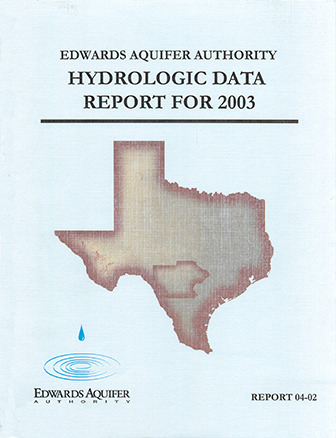Edwards Aquifer Authority Hydrologic Data Report for 2003

| Author | Hamilton JM, Johnson S, Esquilin R, Thompson EL, Wiatrek A, Luevano G, Gregory D, Burgoon C, Mireles J, Gloyd R, Sterzenback J, Mendoza R, Hoyt JR, Parker E and Schindel GM |
| Year | 2004 |
| Description | Annual report for 2003 on recharge, discharge, water levels and water quality in the Edwards Aquifer San Antonio Region |
| Report Number | 04-02 |
| Publisher | Edwards Aquifer Authority |
| Location | Edwards Aquifer - San Antonio Area |
| Cover | View Download |
| File | View Download |
| Summary |
|
(Excerpted from the report Summary) Water levels remained well above average at the Bexar County (J-17) index well throughout 2003. Other index wells in the region exhibited similar behavior. … Precipitation in the Edwards Aquifer region was generally slightly below average in 2003, except in Hondo where precipitation exceeded the annual average by approximately 21 percent. … The highest rainfall volumes were recorded in west central Real, central Bandera, central Medina, and southern Comal counties. … In 2003, total recharge to the Edwards Aquifer was 669,000 acre-feet. This recharge volume is approximately 20 percent above the median of 559,400 acre-feet for the period of record (1934-2003) and approximately four percent below the mean of 698,500 acre-feet for the period of record (1934-2003). … Nitrate as nitrogen concentrations ranged from below the laboratory reporting limit of concentrations were detected above 5.0 mg/L in five wells. The volatile organic compound (VOC) tetrachloroethene (PCE) was detected in one well sample at a concentration equal to its MCL of 5.0 μg/L. PCE was not detected above the MCL in any of the samples collected in 2003. The results of the 2003 water quality sampling indicate that water quality in the aquifer is generally excellent. Edwards Aquifer water is generally of such high quality that it normally requires only chlorination to meet public drinking water standards. However, the detection of trace quantities of metals and organic compounds in the aquifer is a concern and the Authority will continue to monitor for these compounds to determine possible sources and trends. Quantification of many of the metals and organic compounds at the low concentrations indicated in the report can be problematic and continued monitoring will be required to confirm their presence or absence. The Authority’s aquifer-wide water quality sampling program will continue to monitor wells, streams, and springs for indications of water quality impacts. Authority staff and cooperating agencies will continue to analyze any anomalous data and investigate possible sources of contamination. |
Search for Documents
Advance Search
Explore EAA's Scientific Reports
- All Reports
- Geomorphology and Caves
- Weather Modification
- Geology
- Water Use and Conservation
- Geochemistry
- Water Resources Planning and Management
- Floods and Drought
- Water Quality
- Climatology
- Surface Water / Groundwater Relationship
- Biology
- Springs, Groundwater Discharge
- Archaeology
- RZ Protection
- Aquifer Levels
- Remote Sensing
- Precipitation
- Overview Studies
- Modeling
- Hydrology and Hydrogeology
- History
- Groundwater Recharge, Recharge Zone
- Groundwater Movement
